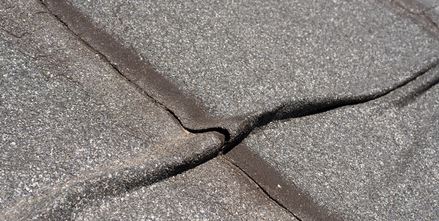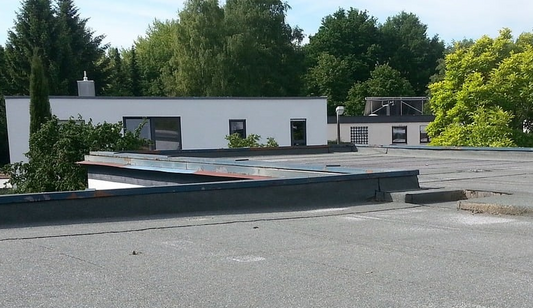Installing a fleece backed EPDM roof membrane is a straightforward process when you follow the proper sequence of preparation, application, and finishing.
Below is a step-by-step guide to ensure a watertight, professional installation.
Step 1: Prepare the Roof Deck
Begin with a fully installed OSB roof deck.
Tools Needed:
- Cordless drill and countersink bits
- Countersink screws
- Belt sander
- Leaf blower
Countersink all screw holes to make the roof deck surface flat.
Screw into the roof deck and ensure all screw heads are flush.
Sand any deck joints or rough spots for a smooth finish.
Remove dust and debris completely using a leaf blower.
Step 2: Mark Out Adhesive Zones
Tools Needed:
- Combination square (set to 150 mm)
- Marker pen
Use the combination square to mark a 150 mm perimeter around the roof deck edge for the contact adhesive. Mark the entire perimeter at this distance.
Step 3: Position and Size the EPDM Membrane
Unroll the membrane and place it on the roof deck.
Cut lengths to overhang the roof edge by approximately 100 mm.
Fold the membrane back and mark it at 150 mm along the perimeter for adhesive zones. Match these marks to the deck.
Step 4: Apply Adhesive and Lay the Membrane
Tools & Materials Needed:
- Medium pile paint roller and pole
- Water-based deck adhesive
- Broom
Fold the membrane for easier handling.
Apply an even coat of water-based deck adhesive to the exposed deck area, keeping adhesive within the marked 150 mm zone.
Roll the membrane back into position, adhering it to the glued area.
Use a broom to press the membrane down, removing air bubbles and ensuring good contact.
Repeat for remaining areas, working section by section.
Step 5: Joining Overlapping Membrane Sections
Overlap sheets as required; ensure seam tape aligns properly with blank edges.
Mark a 150 mm strip along sheet edges for adhesive application.
Apply water-based deck adhesive and lay the next sheet, using a broom to secure and smooth out.
Step 6: Priming and Taping the Seams

Use a spirit level straight edge to mark a priming line on the lower sheet.
Brush on EPDM primer along the marked area and wait until touch dry.
Carefully lift the overlap, peel away the seam tape backing at a 45° angle, and smooth the membrane down.
Use a silicone roller to press the seam and activate the tape all along the join.
Step 7: Applying Contact Adhesive to Perimeter and Wall Upstand
Fold back the membrane edge.
Brush contact adhesive along the 150 mm strip at the roof edge and on the underside of the membrane.
Protect fascia and structures below as needed; allow adhesive to become touch dry.
Lay down and smooth the membrane into place.
For wall upstand connections:
Brush contact adhesive to the wall upstand and roof deck edge.
Once dry, press and smooth the membrane into the angled transition and onto the wall.
Step 8: Installing Gutter Trim and Roof Edge Details
Materials Needed:
- Gutter trim back plate and front plate
- Ring shank nails or polytop nails
- Fixing pins
Position gutter trim back plate 1–2 mm below roof deck surface. Secure with nails.
When adhesive is dry, fold membrane onto gutter trim back plate.
Prime as needed before seam taping and smoothing into place.
Attach the gutter trim front plate and secure with polytop nails and fixing pins.
Step 9: Detailing with Flashing Tape and Sealants (Corners & Edges)
Cut corners of the EPDM membrane at terminations using a craft knife.
Measure and cut uncured flashing tape into 150 mm wide patches with curved corners.
Prime the patch location on the roof deck, wait until touch dry, then apply the patch and press into all angle changes using a silicone and penny roller.
Apply a protective bead of lap edge sealant around all flashed patches.
Step 10: Installing Raised Kerb Trim
Cut the raised kerb trim to size with a saw or multi cutter.
Remove any protective films, tuck the membrane, and compress the foam strip on the trim for a watertight seal.
Nail down with polytop nails in all pre-drilled holes, and fix the trim at each corner with pins.
For external corners:
Snap out the corner component, glue, and activate as directed.
Fit into the gutter trim corner.
Trim any excess membrane, being careful not to damage the fascia.
Final Steps
Go over all membrane edges, ensuring adhesion and good joins at seams and trims.
Clean up and inspect for any issues.
Your fleece backed EPDM membrane installation is now complete, providing a robust, weatherproof surface.




